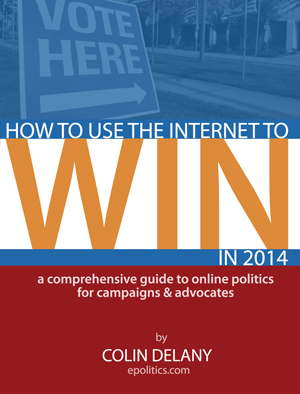The following is an excerpt from the new ebook, “How to Use the Internet to Win in 2014: A Comprehensive Guide to Online Politics for Campaigns & Advocates”, available in the Amazon store for the Kindle e-reader and as a PDF here on Epolitics.com.
From Chapter Nine, “Data and Anaytics”: Social Media Data
Another area in which metrics are both available and useful: social media. At a basic level, campaigns should note how many people are following their Twitter feeds and Facebook pages, but these two numbers won’t tell you much in isolation (in fact, they’re frequently referred-to as “vanity metrics,” because people try to drive them higher ’cause it looks good).
Here are a few analytics that DO matter on social media, which are fortunately usually relatively easy to track:
- Who’s following you? (Follow up questions: Do you recognize them? Are they in your district? Are they “influencers” you’re trying to reach?)
- Is your following increasing, decreasing, or holding steady? What’s the trend over time?
- Are people interacting with your content? On Facebook, are they Liking/Commenting/Sharing? On Twitter, are they retweeting your info or replying to it?
- Which of your posts are generating activity on Facebook or Twitter? Certain issues? Particular kinds of content, for instance photos/images vs. links to articles?
Facebook gives Page owners access to an analytics tool it calls “Insights,” which (like everything else on Facebook) changes constantly. As of this writing, this article provides a good overview, but keep in mind that they may be different by the time you read this book.
To track the performance of your Facebook content, you can always create a spreadsheet of your Facebook posts, just as with your fundraising and other emails. In the case of Facebook, you’d list the post title (or some other information that’ll help you identify it), the date posted, and the individual numbers of Likes/Shares/Comments each post generated.
Likewise, a spreadsheet is your friend on Twitter — again, you’d list your tweets and when they were posted (include a URL for the Tweet for later reference), along with how often they were retweeted. If possible, you might also list WHO retweeted them, a measure of whom you’re influencing on Twitter.
But keep in mind that social media analytics are just means to an end: understanding your audience and the content that engages them.
Facebook Custom Audiences
Facebook Custom Audiences are a new way to tie data to Facebook outreach, since they let you upload an email list to use to target Facebook ads. Check out the chapter on digital advertising for more details.
Social Voter-to-Voter Tools
Another relatively new development, which the Obama 2012 campaign used to tap voters it couldn’t reach through other channels: tapping your Facebook supporters’ social connections by comparing their “friend” lists with the voter file you’re trying to contact. Critically, your supporters need to CHOOSE to allow your campaign to access their friends, but once they’ve agreed to do so, the technology matches them with individual voters the campaign has prioritized for contact based on its voter file data. Then, you can ask those supporters to email or call the targeted voter or post content to his or her Facebook page.
The Obama campaign apparently developed their own platform to accomplish this task, which particularly helped them reach voters under age 30 in battleground states. Other vendors — NGPVAN was the first that I know of — offer similar technologies, with Republican Ken Cuccinelli using one version in Virginia in 2013.
Of course, these tools will only help if you’ve first done the work of 1) building a sizable Facebook following, and 2) creating a list or data model of the voters you need to reach.
Message Testing
Campaigns traditionally test their basic messaging using polls, focus groups and their own judgment. Pollsters beware, though: online data now give staff new tools to evaluate the themes, issues, framing and wording they use to define their candidate….
For more from the “Data and Analytics” chapter, please pick up your own copy of “How to Use the Internet to Win in 2014”

